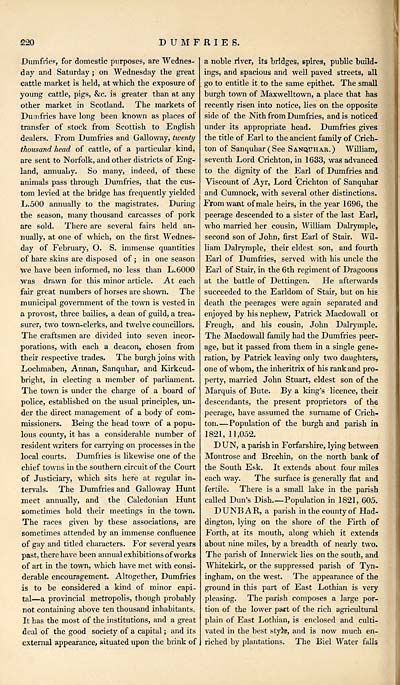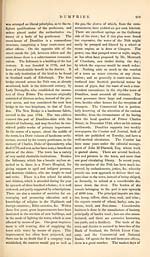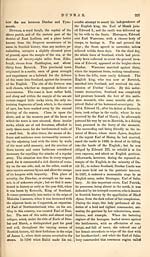Gazetteer of Scotland > Volume 1
(250) Page 220
Download files
Complete book:
Individual page:
Thumbnail gallery: Grid view | List view

220
DUMFRIES.
Dumfries, for domestic purposes, are Wednes-
day and Saturday ; on Wednesday the great
cattle market is held, at which the exposure of
young cattle, pigs, &c. is greater than at any
other market in Scotland. The markets of
Dumfries have long been known as places of
transfer of stock from Scottish to English
dealers. From Dumfries and Galloway, twenty
thousand head of cattle, of a particular kind,
are sent to Norfolk, and other districts of Eng-
land, annuaLy. So many, indeed, of these
animals pass through Dumfries, that the cus-
tom levied at the bridge has frequently yielded
L.500 annually to the magistrates. During
the season, many thousand carcasses of pork
are sold. There are several fairs held an-
nually, at one of which, on the first Wednes-
day of February, O. S. immense quantities
of hare skins are disposed of ; in one season
we have been informed, no less than L.6000
was drawn for this minor article. At each
fair great numbers of horses are shown. The
municipal government of the town is vested in
a provost, three bailies, a dean of guild, a trea-
surer, two town-clerks, and twelve councillors.
The craftsmen are divided into seven incor-
porations, with each a deacon, chosen from
their respective trades. The burgh joins with
Lochmaben, Annan, Sanquhar, and Kirkcud-
bright, in electing a member of parliament.
The town is under the charge of a board of
police, established on the usual principles, un-
der the direct management of a body of com-
missioners. Being the head towr. of a popu-
lous county, it has a considerable number of
resident writers for carrying on processes in the
local courts. Dumfries is likewise one of the
chief towns in the southern circuit of the Court
of Justiciary, which sits here at regular in-
tervals. The Dumfries and Galloway Hunt
meet annually, and the Caledonian Hunt
sometimes hold their meetings in the town.
The races given by these associations, are
sometimes attended by an immense confluence
of gay and titled characters. For several years
past, there have been annual exhibitions of works
of art in the town, which have met with consi-
derable encouragement. Altogether, Dumfries
is to be considered a kind of minor capi-
tal — a provincial metropolis, though probably
not containing above ten thousand inhabitants.
It has the most of the institutions, and a great
deal of the good society of a capital ; and its
external appearance, situated upon the brink of
a noble river, its bridges, spires, public build-
ings, and spacious and well paved streets, all
go to entitle it to the same epithet. The small
burgh town of Maxwelltown, a place that has
recently risen into notice, lies on the opposite
side of the Nith from Dumfries, and is noticed
under its appropriate head. Dumfries gives
the title of Earl to the ancient family of Crich-
ton of Sanquhar (See Sanquhar.) William,
seventh Lord Crichton, in 1683, was advanced
to the dignity of the Earl of Dumfries and
Viscount of Ayr, Lord Crichton of Sanquhar
and Cumnock, with several other distinctions.
From want of male heirs, in the year 1696, the
peerage descended to a sister of the last Earl,
who married her cousin, William Dalrymple,
second son of John, first Earl of Stair. Wil-
liam Dalrymple, their eldest son, and fourth
Earl of Dumfries, served with his uncle the
Earl of Stair, in the 6th regiment of Dragoons
at the battle of Dettingen. He afterwards
succeeded to the Earldom of Stair, but on his
death the peerages were again separated and
enjoyed by his nephew, Patrick Macdowall oi
Freugh, and his cousin, John Dalrymple.
The Macdowail family had the Dumfries peer-
age, but it passed from them in a single gene-
ration, by Patrick leaving only two daughters,
one of whom, the inheritrix of his rank and pro-
perty, married John Stuart, eldest son of the
Marquis of Bute. By a king's licence, their
descendants, the present proprietors of the
peerage, have assumed the surname of Crich-
ton. — Population of the burgh and parish in
1821, 11,052.
DUN, a parish in Forfarshire, lying between
Montrose and Brechin, on the north bank of
the South Esk. It extends about four miles
each way. The surface is generally flat and
fertile. There is a small lake in the parish
called Dun's Dish.— Population in 1821, 605.
DUNBAR, a parish in the county of Had-
dington, lying on the shore of the Firth of
Forth, at its mouth, along which it extends
about nine miles, by a breadth of nearly two.
The parish of Innerwick lies on the south, and
Whitekirk, or the suppressed parish of Tyn-
ingham, on the west. The appearance of the
ground in this part of East Lothian is very
pleasing. The parish composes a large por-
tion of the lower part of the rich agricultural
plain of East Lothian, is enclosed and culti-
vated in the best styfe, and is now much en-
riched by plantations. The Biel Water falls
DUMFRIES.
Dumfries, for domestic purposes, are Wednes-
day and Saturday ; on Wednesday the great
cattle market is held, at which the exposure of
young cattle, pigs, &c. is greater than at any
other market in Scotland. The markets of
Dumfries have long been known as places of
transfer of stock from Scottish to English
dealers. From Dumfries and Galloway, twenty
thousand head of cattle, of a particular kind,
are sent to Norfolk, and other districts of Eng-
land, annuaLy. So many, indeed, of these
animals pass through Dumfries, that the cus-
tom levied at the bridge has frequently yielded
L.500 annually to the magistrates. During
the season, many thousand carcasses of pork
are sold. There are several fairs held an-
nually, at one of which, on the first Wednes-
day of February, O. S. immense quantities
of hare skins are disposed of ; in one season
we have been informed, no less than L.6000
was drawn for this minor article. At each
fair great numbers of horses are shown. The
municipal government of the town is vested in
a provost, three bailies, a dean of guild, a trea-
surer, two town-clerks, and twelve councillors.
The craftsmen are divided into seven incor-
porations, with each a deacon, chosen from
their respective trades. The burgh joins with
Lochmaben, Annan, Sanquhar, and Kirkcud-
bright, in electing a member of parliament.
The town is under the charge of a board of
police, established on the usual principles, un-
der the direct management of a body of com-
missioners. Being the head towr. of a popu-
lous county, it has a considerable number of
resident writers for carrying on processes in the
local courts. Dumfries is likewise one of the
chief towns in the southern circuit of the Court
of Justiciary, which sits here at regular in-
tervals. The Dumfries and Galloway Hunt
meet annually, and the Caledonian Hunt
sometimes hold their meetings in the town.
The races given by these associations, are
sometimes attended by an immense confluence
of gay and titled characters. For several years
past, there have been annual exhibitions of works
of art in the town, which have met with consi-
derable encouragement. Altogether, Dumfries
is to be considered a kind of minor capi-
tal — a provincial metropolis, though probably
not containing above ten thousand inhabitants.
It has the most of the institutions, and a great
deal of the good society of a capital ; and its
external appearance, situated upon the brink of
a noble river, its bridges, spires, public build-
ings, and spacious and well paved streets, all
go to entitle it to the same epithet. The small
burgh town of Maxwelltown, a place that has
recently risen into notice, lies on the opposite
side of the Nith from Dumfries, and is noticed
under its appropriate head. Dumfries gives
the title of Earl to the ancient family of Crich-
ton of Sanquhar (See Sanquhar.) William,
seventh Lord Crichton, in 1683, was advanced
to the dignity of the Earl of Dumfries and
Viscount of Ayr, Lord Crichton of Sanquhar
and Cumnock, with several other distinctions.
From want of male heirs, in the year 1696, the
peerage descended to a sister of the last Earl,
who married her cousin, William Dalrymple,
second son of John, first Earl of Stair. Wil-
liam Dalrymple, their eldest son, and fourth
Earl of Dumfries, served with his uncle the
Earl of Stair, in the 6th regiment of Dragoons
at the battle of Dettingen. He afterwards
succeeded to the Earldom of Stair, but on his
death the peerages were again separated and
enjoyed by his nephew, Patrick Macdowall oi
Freugh, and his cousin, John Dalrymple.
The Macdowail family had the Dumfries peer-
age, but it passed from them in a single gene-
ration, by Patrick leaving only two daughters,
one of whom, the inheritrix of his rank and pro-
perty, married John Stuart, eldest son of the
Marquis of Bute. By a king's licence, their
descendants, the present proprietors of the
peerage, have assumed the surname of Crich-
ton. — Population of the burgh and parish in
1821, 11,052.
DUN, a parish in Forfarshire, lying between
Montrose and Brechin, on the north bank of
the South Esk. It extends about four miles
each way. The surface is generally flat and
fertile. There is a small lake in the parish
called Dun's Dish.— Population in 1821, 605.
DUNBAR, a parish in the county of Had-
dington, lying on the shore of the Firth of
Forth, at its mouth, along which it extends
about nine miles, by a breadth of nearly two.
The parish of Innerwick lies on the south, and
Whitekirk, or the suppressed parish of Tyn-
ingham, on the west. The appearance of the
ground in this part of East Lothian is very
pleasing. The parish composes a large por-
tion of the lower part of the rich agricultural
plain of East Lothian, is enclosed and culti-
vated in the best styfe, and is now much en-
riched by plantations. The Biel Water falls
Set display mode to: Large image | Transcription
Images and transcriptions on this page, including medium image downloads, may be used under the Creative Commons Attribution 4.0 International Licence unless otherwise stated. ![]()
| Gazetteers of Scotland, 1803-1901 > Gazetteer of Scotland > Volume 1 > (250) Page 220 |
|---|
| Permanent URL | https://digital.nls.uk/97427362 |
|---|
| Description | Volume I: Abbey to Glenartney. |
|---|---|
| Attribution and copyright: |
|
| Description | By Robert Chambers and William Chambers. Glasgow: Blackie & Son, 1838. 2 volumes. |
|---|---|
| Shelfmark | NF.1461.g.7 |
| Additional NLS resources: | |

